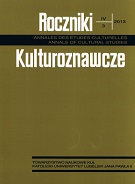Inspiracje tekstów starotestamentalnych i apokryfów żydowskich w średniowiecznych wyobrażeniach scenicznych Księgi Rodzaju
Inspirations of Old Testament Texts and Jewish Apocrypha in Medieval Scenic Representations of the Book of Genesis
Author(s): Małgorzata Urszula MazurczakSubject(s): Cultural Essay, Political Essay, Societal Essay
Published by: Towarzystwo Naukowe KUL & Katolicki Uniwersytet Lubelski Jana Pawła II
Keywords: iconography of the creation of man; medieval anthropology of image; figure of the Law; ikonografia stworzenia człowieka; średniowieczna antropologia obrazu; symbolika Prawa
Summary/Abstract: The iconography of the Book of Genesis has been elaborated on in extensive studies in which connections with the biblical text and commentaries, mainly patristic, have been demonstrated. In the state of research gathered on this subject by U. Mazurczak in ‘Das Sechstagewerk in der Ikonographie des Mittelalters. Forschungsstand und Forschungsperspektiven’ (Acta Mediaevalia 8:1995) the author pointed out crucial research problems which were worth further studying in the iconography of ‘Genesis’. Moreover, in a book published in 2012 Human corporeality in medieval Italian painting (Vol. 1. Lublin 2012) the issues of the created body and its significance in the realm of medieval anthropology were presented. In the present study selected texts of Jewish apocrypha and philosophical commentators, which inspired Christian representations of illustrations for the Book of Genesis: the creation of man and his sojourn in the paradise as well as his departure after the original sin, have been pointed out. Jewish tradition in the images of angels in the illustrations of Cotton’s Bible, repeated on mosaics in the narthex of St. Mark’s Church in Venice has been also indicated. Those figures bear resemblance to the texts by Philo of Alexandria who explained the significance of angels appearing next to God in the subsequent days in his commentary On the creation of the world. The number of angels from the first to the seventh refers to each day being created. Elements of Jewish tradition can be also traced in the famous Bible of Czerwińsk (1148-1155), destroyed during World War II, where God the Creator was depicted together with three angels. God the Father anoints the first angel with the same gesture as he touches Adam’s forehead, which is shown in the following medallion. In this way Philo interpreted the creation of mind as stamping it with the wisdom of God the Creator who imprinted his stigma in man’s mind. The apocrypha called the Book of Jubilees was of significant importance—the list of angels’ (residents’ of heaven) powers was enumerated there. They rule over cosmic powers and over man on the earth. In the Book the dialogical form between God and the angels is developed and the gesture of touch is also explained here as it was presented in a codex once stored in Polish collection. The touch is a sign of the deep connection between man and Yahweh who reveals himself in a special way on the day of Sabbath—The Day of God’s Glory. With the sign of touching Adam’s forehead God gave his blessing to man on the seventh day, namely the day of consecration.
Journal: Roczniki Kulturoznawcze
- Issue Year: 4/2013
- Issue No: 3
- Page Range: 51-73
- Page Count: 23
- Language: Polish

